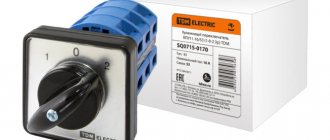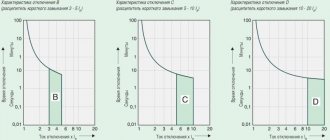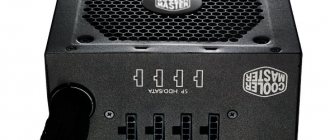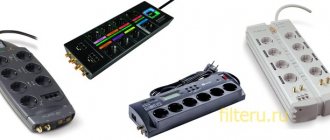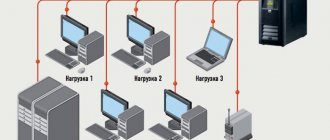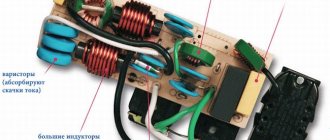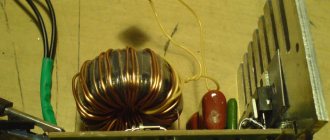The biggest difference between a UPS and a fused protective strip is the simple fact that the UPS has a battery and the strip does not; This makes it much more expensive and takes up much more space, which is why quite a few users choose to go without a UPS and instead have a protective strip to protect their equipment from problems in the electrical network.
Contents [show]
- Why buy security tapes?
- Why isn't a cheap extension cord worth it?
- Best Security Tapes on the Market APC Surge Protection Features
- Brennenstuhl Premium Line
- EATON protective box
- Salicru SPS.Safe 7
- Belkin SurgeStrip
- Trust 21059
UPS for computer
UPS (English UPS) is a separate external power supply unit that ensures the operation of the computer when the mains power is turned off. In addition, some models adjust the computer's power settings when they go beyond acceptable limits, which is important for increasing the service life of the computer.
Desktop computers, servers, and communication devices such as routers and routers are connected to the network via a UPS.
Important! There is no need to connect a laptop via a UPS - the rechargeable battery built into the device body automatically protects the laptop from network problems.
The principle of operation of an uninterruptible power supply for a PC (server)
The source of uninterrupted operation of alternating current is a device in which there is always power. However, it is worth considering that this is not a backup power source, but an emergency one - it turns on in the event of “force majeure” and only for a short time.
The main function of the UPS - instantaneous power supply when the main network voltage is turned off - is implemented using a rechargeable battery that stores energy. The charger built into the UPS case monitors the voltage level on the battery, switching into recharging mode if necessary.
When the voltage in the network disappears, the control device turns off the computer from the network and simultaneously connects the PC to the battery. The built-in inverter converts the DC voltage of the battery into alternating voltage, increasing it to the operating voltage of 220 V.
When turned on in operating mode, the uninterruptible power supply emits a sound or light signal, notifying the user of problems with the PC’s power supply.
Depending on the battery capacity and the power of the computer, the uninterruptible power supply provides alternating voltage at the output for a short time, which is necessary to save the current session and shut down the computer.
What does a UPS consist of?
UPS unit components:
- batteries for energy storage;
- charger that maintains battery performance;
- an inverter that converts direct current into alternating current;
- control circuit.
Connection method
The UPS is equipped with several output sockets located on the rear panel of the device. Connecting a personal computer and peripherals, the disconnection of which could have negative consequences, with the appropriate cables will not be difficult if you follow the procedure:
- after the first charge, disconnect the uninterruptible power supply from the network;
- turn off the computer;
- connect the computer’s network cable to the appropriate connector of the UPS;
- connect the UPS network cable to the network;
- press and hold the UPS power button, wait for a light or sound signal to start working;
- turn on the computer;
- install UPS drivers.
Network filters
When connecting any electronics to the network, it is recommended to use a surge protector.
Why do you need a surge protector? - you ask.
The purpose of a surge protector is to protect the power supply circuits of electronic equipment from interference such as:
- Voltage surges
- Voltage pulse
- Noise interference
For example, if a voltage of more than 220V suddenly flows through the network, the surge protector will protect the computer from it.
How to choose? The following parameters should be taken into account:
- Rated voltage/frequency 220 V/50 Hz. In the USA and European countries the frequency is 60 Hz, in Russia 50 Hz.
- Maximum load current. To determine how much current the electronics consume, you need to solve the example using the formula: I=P\U, where is the current strength, P is the power of the electrical appliance, U is the network voltage. The power consumption of a computer is usually written on the power supply or in the manual, or search the Internet for a description of your computer model.
- Reducing impulse noise. What is impulse noise? When, as a result of switching, various accidents, disconnection of consumers, etc., a short-term voltage surge occurs in the electrical network, increasing at that moment hundreds of times and for a fraction of a second. But this is enough to damage the computer. Example parameters: 4 kV – 5/50 ns at least 10 times or 4 kV – 1/50 µs at least 4 times. What does it mean? The surge protector will be able to withstand a dozen pulses of 4 kilovolts if they last five fiftieths of a nanosecond and four pulses of 4 kilovolts if the duration is one fiftieth of a microsecond.
- Interference current withstood by the limiter. These are currents that occur during overloads, their value is expressed in kiloamperes. The limiter can be fusible or automatic.
- Maximum absorbed energy. In cheap models, only the phase is absorbed, while in more expensive models, phase, zero and ground are absorbed. It is indicated in joules.
- Voltage limitation level for interference current. In this parameter ± 100V is not critical.
- Reducing high-frequency interference. For example, a turned-on drill interferes with the TV. This is high-frequency interference in the electrical network. This parameter indicates the ability of the filter to smooth out interference in the network at a certain frequency. For example, 0.1 MHz – 7 dB, 1 MHz – 12.5 dB, 10 MHz – 20.5 dB. The higher the dB value, the more noise the filter can absorb.
- Power consumption.
This is the power consumed by the surge protector itself. In expensive models, this figure will be higher, since better protection requires greater energy consumption.
Types of uninterruptible power supplies
Uninterruptible power supplies are classified into three types depending on the design diagrams:
- The backup is used to switch to battery power.
- Interactive is used for linear-interactive uninterruptible power supplies.
- The double conversion circuit is designed for online power supplies.
Backup sources
An offline UPS or backup source is needed for home computers and supporting local networks in offices.
The principle of operation is to automatically switch the PC to battery power when there is a power outage. The role of the switch is played by a mechanical relay, which is why the UPS makes clicking sounds when operating modes change.
Linear operational
Such UPS are used to protect network and telecommunication equipment or a group of computers from surge voltages.
The peculiarity of the operation is to protect the PC from overvoltage or undervoltage without going into emergency mode due to the inclusion of an autotransformer in the circuit.
Online power supplies (for servers)
Powerful double conversion UPS are used for file servers, server workstations and network devices that are power hungry.
Features of the operation - the input alternating voltage is converted by a rectifier into direct voltage, then through an inverter into a reference alternating voltage, which is supplied to the devices. The battery is constantly connected to the output of the rectifier and the input of the inverter and constantly powers them in emergency mode.
Online UPS provide stable voltage on servers and zero switching time to batteries.
Why does interference occur on the home network?
The reasons for unstable power supply are different: poor performance of generators, emergencies at substations, problems with wiring, deviations from the norm due to the inclusion of powerful equipment such as welding machines and electric motors.
Poor-quality power supply negatively affects the operation of any PC: possible loss of data on HDD drives, failure of the power supply, etc. Systematically recurring problems with the network cause premature aging of electronic elements.
How to choose a UPS for your computer
To correctly select an uninterruptible power supply that is ideal for maintaining the functionality of your computer, you need to take into account some of the characteristics of the device.
By power
An important characteristic of an uninterruptible power supply is power; the reliability of protection against voltage surges and service life depend on it:
- Apparent power is measured in VA and characterizes the maximum amount of power that can be connected to an uninterruptible power supply.
- Active power is measured in W - this is the maximum power of devices connected to the UPS. The power of the uninterruptible power supply should be 20-30% more.
We calculate the total active power of the equipment that we plan to connect to an uninterruptible power supply, add thirty percent to this number and determine the power of the UPS. For example, the power of a home PC is 420 W and the power of a monitor is 45 W - a total of 465 W, which means you will need a UPS with a power of at least 600 W.
Special lightning protection
Rarely, but accurately - and on the spot. This is how a lightning discharge works, suddenly peeking into a home through electrical outlets or a modem, and in a split second it disables any computer along with its peripherals.
Rest assured - ABSOLUTELY EVERYTHING WILL BURN. To begin with, PSU, processor, network card and motherboard. Then all the peripherals, not even working, but simply plugged into the outlet. It’s no joke, the magnitude of the lightning pulse current reaches half a million amperes, and the voltage reaches tens of millions of volts.
If you live in an apartment building, then to some extent you have the right to rely on the protection systems of the stationary electrical network. And in a private house or country house, the risk of being struck by lightning overcurrents is much higher (especially for buildings located on a hill).
Both voltage stabilizers and UPSs are powerless against the forces of the elements; they will not cope with the heavy load and will burn out together with the computer. What about built-in fuses? Alas, even in expensive models there are no systems that can become a real barrier against surge voltages - this is too expensive and technologically difficult to implement.
Life in a thunderstorm is possible if you install inexpensive special protection
Working calmly when the elements are raging outside the window and lightning is flashing is not the lot of a desperate optimist, but of a practical realist who has installed a SPARKER FOR PROTECTION AGAINST LIGHTNING. A special compact device for lightning protection is also called a “surge suppressor” and is mounted in the electrical panel.
The operating principle is quite simple: the design is based on an element made of a metallic conductive alloy. A lightning discharge, falling on it, pierces a metal bar and is grounded, i.e. goes to the ground, diverting danger from the equipment. The process takes a couple of tens of nanoseconds.
A logical question: how many times will the arrester operate?
On average, the resource is enough for a couple of times, but it all depends on the specific situation. Be sure to check the indicator on the case: it will show whether replacement is required after operation. Most often, the need to replace the arrester is indicated by a CHANGE IN THE INDICATOR COLOR FROM GREEN TO RED.
According to Evgeniy, consumer awareness of the benefits and capabilities of arresters has grown significantly over the past couple of years: at least 10 units are sold daily, which was not the case before. Perhaps the rationality and thriftiness of users are growing along with the prices of progressive, productive computer equipment.
How to choose a surge suppressor for a PC
Good news: for an apartment or cottage, a third D-class arrester is sufficient, the lowest and AFFORDABLE IN COST. For example, a decent quality single-pole arrester OPS1-D from IEK costs about 260 UAH.
Moreover, in this case there is NO WORTH CHASING THE PRICE at all; simple limiters also perform their tasks perfectly. And you don’t have to overpay for features like smartphone notifications. By the way, in some places special series for protecting computer cables have appeared on sale, and they are even cheaper.
Images and a table comparing the characteristics of arresters are taken from the AxiomPlus website.
What to do if the arrester is only in your plans?
It's simple: at the first sign of an approaching storm, turn off your computer and router from the network as quickly as possible, and unplug the network cable. Until the elements completely calm down, do not turn on anything. The method is inconvenient and cannot always be implemented (if no one is at home), but 100% working.


